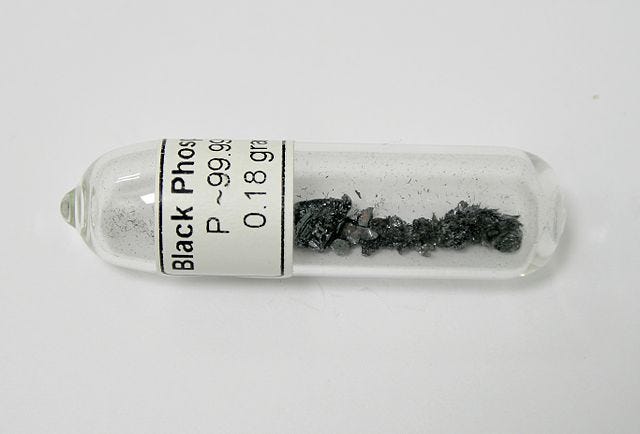Move Over Graphene, Meet the Next Wonder Material
August 19, 2015
Black phosphorus, rather than graphene, could be the first material to herald a new era of nanoelectronic devices.
Kristopher Sturgis
|
Black phosphorous may end up being a better fit for electronics than graphene. Image from Wikipedia. |
When it comes to enhancing transistor technology, thinner is theoretically better. This is why graphene -- a material one-atom thick -- could potentially be an ideal replacement material for silicon transistors. Yet graphene lacks a critical property: in its natural state, it doesn't have a band gap, which causes it to continuously work as a conductor. Researchers at Berkeley have succeeded in making the material work as a semiconductor by making it thicker--stacking two sheets of graphene on top of the other.
But perhaps another material, black phosphorus, is better suited for replacing silicon in electronics. For one thing, the material works as a semiconductor out of the gate. Its ability to have its conductivity, meaning it can be readily switched on and off would enable the binary encoding of 1s and 0s in computer languages.
The key to integrating the material into transistor technology is keeping it thin, constraining electrons to move in only two dimensions. These traits open up a world of possibilities when it comes to applications, specifically in nanoelectronics and wearable sensors.
Recent research out of McGill University and Pohang University of Science and Technology (POSTECH) indicate that the versatile material could be potentially used for an array of applications, including medical sensors.
"One thing that quickly comes up in my mind is [the use of black phosphorus in] the flexible nanoscale sensors that can be attached directly to human skin, monitoring [a person's] medical status," said Kim Keun Su, a professor in physics at POSTECH, where he's been working with a team of scientists to create the first semiconductor from black phosphorus. "For applications in such nano-medical sensors, developments of devices composed of 2-D semiconductors would be very important."
The integration of enhanced transistor technologies into electronics will also have a significant impact on speed and performance.
Since the development of graphene, scientists have been exploring various other two-dimensional materials that could be easily separated into single atomic layers. Black phosphorus quickly emerged as a candidate given its similarities to graphene.
"Black phosphorus has a very similar honeycomb lattice with graphene, but it is strongly puckered," Kim Keun Su said. "The electronic state of black phosphorus could be tuned from a semiconductor to an efficient conductor, depending on the strength of electric field applied."
Deji Akinwande, an associate professor of electrical and computer engineering at the University of Texas in Austin, believes that the largest obstacle for using the material in electronics is manufacturing it on a large scale. But researchers, convinced of its great potential to advance semiconductor technology, are currently working on doing this, he says. "Black phosphorus is arguably the most outstanding of the 2-D atomic materials so far. It has a high bandgap, a property needed to make electronic switches, unlike graphene which cannot offer this."
Researchers continue to work to fine tune graphene for electronics applications, exploring not only how the material could be woven into devices, but also experiment with new methods of giving the material a band gap and shaping the material for integration into flexible electronics and microelectromechanical systems.
Learn more about cutting-edge medical devices at MD&M Philadelphia, October 7-8, 2015. |
Kristopher Sturgis is a contributor to Qmed and MPMN.
Like what you're reading? Subscribe to our daily e-newsletter.
About the Author(s)
You May Also Like


.png?width=300&auto=webp&quality=80&disable=upscale)
